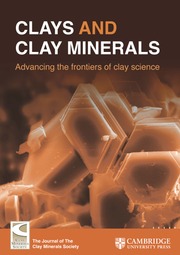Article contents
Equilibration of Clays in Natural and Simulated Bottom-Sediment Environments
Published online by Cambridge University Press: 01 July 2024
Abstract
To identify mineral alterations which might occur in stream environments, predominantly illitic soil clays were equilibrated in bottom sediment environments under natural and laboratory conditions for 217 and 98 days, respectively. Changes occurring after 217 days on the bottom of the Auglaize River, Ohio, consisted of a reduction in carbonate content, a decrease in particle size, and a slight loss of Al and Si; however, no significant changes in basal spacings were observed.
Clays equilibrated in river water under laboratory conditions at 4° and 25°C in CO2, N2, or air atmospheres showed only an increase in oxalate-extractable iron. The concentrations of Al, Si, Fe, Mn, K, and Ca in solution above the clays varied with the atmosphere and temperature. The concentrations of Fe, Al, and Si in solution may have been influenced by the dissolution of amorphous Al-Fe-Si compounds. Therefore, the mineralogical differences between soils in the watershed and sediments in the drainage system can not be attributed to mineralogical transformations during residence in the drainage system.
Резюме
Чтобы распознать минеральные преобразования, которые могут произойти в среде потока, преимущественно иллитовые почвенные глины были уравновешены в среде донных отложений в естественных и лабораторных условиях на протяжении 217 и 98 дней соответственно. Изменения, происшедшие после 217 дней на дне реки Оглаз включали уменьшение содержания карбоната, уменьшение размеров зерен и небольшие потери А1 и Si; однако не было обнаружено существенных изменений в базальных промежутках.
Глины, уравновешенные в речной воде в лабораторных условиях при 4° и 25°С в С02, N2, или воздушной атмосфере, показали только увеличение содержания железа, извлекаемого оксалатом. Концентрации Al, Si, Fe, Мn, K, и Ca в растворе над глинами изменялись в зависимости от атмосферы и температуры. Растворение аморфных соединений Al-Fe-Si возможно повлияло на концентрацию Fe, Al, и Si в растворе. Следовательно, минералогические различия между почвами в бассейне реки и осадками в дренажной системе не могут быть обусловлены минералогическим преобразованием во время пребывания в дренажных системах. [N.R.]
Resümee
Um Mineralumwandlungen zu bestimmen, die in Flußmilieus auftreten können, wurden überwiegend illitische Bodentone in Bodensedimenten unter natürlichen und Labor-Bedingungen für 217 bzw. 98 Tage ins Gleichgewicht gebracht. Die Veränderungen, die nach 217 Tagen auf dem Grund des Auglaize-Flusses auftraten, bestanden in einer Abnahme des Karbonatgehaltes, einer Verkleinerung der Teilchengröße und einem geringen Verlust von Al und Si. Es wurden jedoch keine bemerkenswerten Veränderungen bei den Basisabständen beobachtet.
Tone, die unter Laborbedingungen bei 4° und 25°C in Flußwasser bei CO2-, N2-, und Luft-Atmosphäre ins Gleichgewicht gebracht wurden, zeigen nur eine zunahme des durch Oxalat extrahierbaren Eisens. Die Konzentrationen von Al, Si, Fe, Mn, K, und Ca in der Lösung über den Tonen variiert mit der Art der Atmosphäre und mit der Temperatur. Die Konzentrationen an Fe, Al, und Si in der Lösung könnten durch die Auflösung amorpher Al-Fe-Si-Komponenten beeinflußt werden. Deshalb können die mineralogischen Unterschiede zwischen den Böden im Einzugsgebiet und den Sedimenten im Entwässerungssystem nicht auf mineralogische Veränderungen während des Aufenthalts im Entwässerungssystem zurückgeführt werden. [U.W.]
Résumé
Pour identifier les altérations minérales qui se produire dans des environements fluviaux, des argiles de sol predominément illitiques ont été équilibrées dans des environements de sédiments de lit sous des conditions naturelles et de laboratoire pendant respectivement 217 et 98 jours. Les changements qui se sont produits après 217 jours dans le lit de la rivière Auglaize consistaient en une réduction en contenu en carbonate, en une diminution de la taille de particule, et en une légère perte d'Al et Si; aucun changement significatif n'a cependant été observé dans les espacements de base.
Les argiles équilibrées dans l'eau de rivière sous des conditions de laboratoire à 4° et 25°C dans des atmosphères CO2, N2, ou l'air n'ont montré qu'un accroissement en fer à oxalate qui peut être extrait. Les concentrations en Al, Si, Fe, Mn, K, et Ca en solution au dessus des argiles variaient selon l'atmosphère et la température. Les concentrations en Fe, Al, et Si en solution peuvent avoir été influencées par la dissolution de composés Al-Fe-Si amorphes. Les différences minéralogiques entre les argiles dans la ligne de partage des eaux et dans les sédiments du système de drainage ne peuvent donc pas être attribuées à des transformations minéralogiques se produisant pendant la résidence dans le système de drainage. [D.J.]
Information
- Type
- Research Article
- Information
- Copyright
- Copyright © 1981, The Clay Minerals Society
Footnotes
Journal article No. 8–80.
References
- 1
- Cited by

